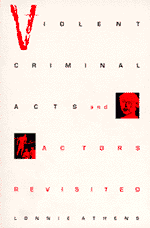

![]()
![]()

The original book, which is reproduced here with only minor amendments, was very much a child of its time. An interactionist study sanctified with a foreword by Herbert Blumer, the book explains interpersonal violence as a process by which actors define themselves. Violence is presented, like non-violent legitimate activity, as a self- conscious interpretative process. In turn the interpretation depends on the actors self image, which along with accounts of action are gleaned here from fifty-eight interviews with offenders. Athens claims that there were four self interpretations of violence: 'physically defensive', where the victim intends to attack; 'frustrative', in which the victim resists an order or wants the offender to perform an unwanted act; 'malefic', where the victim is evil and insulting; and 'frustrative-malefic', a combination of the last two interpretations. The exploration of offenders self images produces three categories: 'violent', relating to a disposal to actual violence; 'incipient violence', relating to the actors tendency towards serious threats of violence; and 'non-violent'. These self-images, Athens explains, relate directly to situational definitions that are regarded as suitable for a range of violent interventions. For instance, those with a violent self image seemed able to define the entire range of situations as ripe for violence on their behalf, while at the other end of the scale offenders with a non violent self image identified only physically defensive situations as requiring violence.
The issue of self-imagery is further explored by relating the concept to the level of violence utilise against the victim, with death and serious injury at one end of the scale and minor injury being a feature of non violent careers. The notion of violent careers is explored in the final part of the original study, illustrating how stable, escalating, de-escalating careers can emerge from the self-images of actors.
Part two of the book features an all too brief section that constitutes an amusingly touchy response to some of the critical reviews received by the original study. Athens is not interested in violence because, as some of his reviewers suggested, he is a moral degenerate, but because he experienced the odd shoot-out, stabbing, attempted rape and murder as a youth. Well we should have been told, why so timid? It is indeed a salutary lesson to malefic reviewers everywhere, that nearly twenty years on the victim can still respond. Although in this case, citing C. Wright- Mills hardly seems sufficient. A large portion of grievous bodily harm, or at least a good kicking would seem more appropriate in dealing with outraged positivists wielding moral outrage. The rest of part two adds very little of interest. The literature review remains wanting, and the attempt to consider the material world that violent criminals inhabit, rapidly degenerates into a sloppy discussion of 'phantom communities'. The five pages of 'policy implications' probably took longer to read than they did to write, and provide a reminder of the weakness of qualitative studies that deny, or in this case make mere token gestures, to the structural parameters of their subjects inner worlds.
If part two was really warranted, it would have been to expand on the original material in the light of more contemporary work on violence, and maybe to re-consider some of the categories into which the data is occasionally uncomfortably jammed. Certainly a consideration of some of the explicitly instrumental violence that typifies the worlds of professional and organised crime, in the light of the explanatory, often neutralising categories in this book, would have been most welcome, and an ideal project for this updated edition. Further, this reviewer remains concerned that if Athens is right that self image is related to action, why, even in situations interpreted as physically defensive, do those with a non-violent self images engage in violence?
However, the current academic interest in violence does warrant this book reappearing in the bookshops. The interview extracts are interesting and the categories thought provoking. The incantation of interactionists most venerable priesthood, when the going, or at least the data, gets tough, does date this book, while providing a reminder of times when the study of crime, for all its naivety, was not tainted by purely instrumental concerns. Indeed one of the outstanding features of this curiously engaging book is that it is unlikely to find its way onto the reading lists of criminal justice degrees. Not so much of a revisitation, more a disinterment of a book with a trace of a pulse.
Dick Hobbs
University of Durham